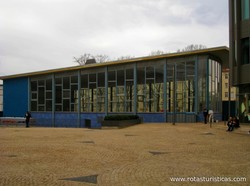




The Tränenpalast (English: "Palace of Tears") is the Berlin colloquialism for the former border crossing at Berlin Friedrichstraße station, where East Germans said goodbye to visitors going back to West Germany. From 1962 to 1989 the it was the central transfer point for travellers by train between East and West Germany. It was used only for westbound crossings, with separate checkpoints for West Berliners, West Germans, foreigners, diplomats, transit travellers and East Germans.
The word derives from the tearful goodbyes that took place in front of the building, where western visitors had to say farewell to East Germans that were not permitted to travel to West Berlin.
Although Berlin Friedrichstraße station was entirely in the Soviet sector of Berlin, because of the Berlin Wall some S-bahn and U-bahn lines were accessible only from West Berlin. West Berlin travellers could use the station to transfer between those lines, or to cross into East Germany. The Tränenpalast was built after the volume of traffic and the constraints of the lower level of the main building made it necessary to expand.
After the fall of the Berlin Wall, the building was used as a nightclub and stage until 2006. It has been a listed building since 1993, a unique symbol of the diverse fates of people on both sides of the border during the German separation. Whether arriving in or leaving East Berlin, travellers came to expect harsh, stressful encounters with border guards. Friends and families never knew if they would see each other again.
On 15 September 2011, the Stiftung Haus der Geschichte opened a permanent exhibition to remind visitors of the consequences and daily restrictions due to the German separation. In an area of 550 square metres, original artefacts, documents, photographs and audio and video recordings show the experiences at the checkpoint and give an overview of the reunification process.
It was opened by Chancellor Merkel on 14 September 2011. In the first two weeks more than 30,000 people visited; entrance is free.
The word derives from the tearful goodbyes that took place in front of the building, where western visitors had to say farewell to East Germans that were not permitted to travel to West Berlin.
Although Berlin Friedrichstraße station was entirely in the Soviet sector of Berlin, because of the Berlin Wall some S-bahn and U-bahn lines were accessible only from West Berlin. West Berlin travellers could use the station to transfer between those lines, or to cross into East Germany. The Tränenpalast was built after the volume of traffic and the constraints of the lower level of the main building made it necessary to expand.
After the fall of the Berlin Wall, the building was used as a nightclub and stage until 2006. It has been a listed building since 1993, a unique symbol of the diverse fates of people on both sides of the border during the German separation. Whether arriving in or leaving East Berlin, travellers came to expect harsh, stressful encounters with border guards. Friends and families never knew if they would see each other again.
On 15 September 2011, the Stiftung Haus der Geschichte opened a permanent exhibition to remind visitors of the consequences and daily restrictions due to the German separation. In an area of 550 square metres, original artefacts, documents, photographs and audio and video recordings show the experiences at the checkpoint and give an overview of the reunification process.
It was opened by Chancellor Merkel on 14 September 2011. In the first two weeks more than 30,000 people visited; entrance is free.
| Shared by: Cristina Nascimento | No comments yet |
| Views: 5731 | |
Share the places of interest to be visited, places you visited on your vacation, or places in your home town that you want to promote.
GPS coordinates
Lat : 52.521065 - Lon : 13.387206
N52° 31' 15.834 " E13° 23' 13.9416"
Comments
Still has no comments for
Palace of Tears
If you know Palace of Tears Leave your comment
Palace of Tears
If you know Palace of Tears Leave your comment
THANK YOU

